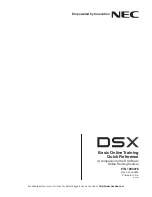
The Grand Tour
Buttons
Strata DK Digital Telephone
5/99
5
Flexible Buttons
All flexible buttons must be programmed for your telephone in system programming and vary
for individual telephones. If a button does not appear on your display or telephone keystrip
label, see your System Administrator for button assignments.
Line Buttons
You may have buttons designated as
/LQH
and/or
3RROHG/LQH*US
which enable you to
directly access outside Central Office (CO) lines.
3RROHG/LQH*US
enables you to access
available CO Lines from a group of lines appearing under one button.
If your telephone does not have a
/LQH
or
3RROHG/LQH*US
button and you want to access
outside CO lines, you can use access codes. For a listing of these codes, see
“Access Codes”
on Page 109
.
Directory Number [DN] Buttons
The [DN] buttons consist of: [PDNs], [SDNs], and [PhDNs]. They are used to initiate or
answer a call and are known as your extension or intercom number(s). You can have multiple
[DN] buttons on your telephone (see
Figure 2
), including [DNs] belonging to another
telephone, [SDNs].
Incoming calls ring your telephone’s [PDNs] from the top down. For example, incoming calls
to Station 10’s [PDNs] first ring the “10-1” button, then “10-2,” and finally “10-3.” Your
[PDN] is considered busy only when all of the [PDNs] are being used by your telephone or
other telephones, and/or when your telephone is on any type of CO Line or [DN] call.
6SNU
(Speaker)
➤
Press to toggle the speaker ON/OFF. The LED indicates the status of the
speaker.
Notes
♦
6SNU
must be pressed and held down when switching from Handset to
Speakerphone mode.
♦
Also selects a line or the internal [PDN] if programmed for auto preference
in system programming. Can be used to disconnect on-hook
speakerphone calls.
9RO
▲
9RO
▼
➤
Press to adjust volume levels (see
“Volume Controls” on Page 10
).
Table 1
Fixed Button Definitions
(Continued)
Button
Definitions
















































